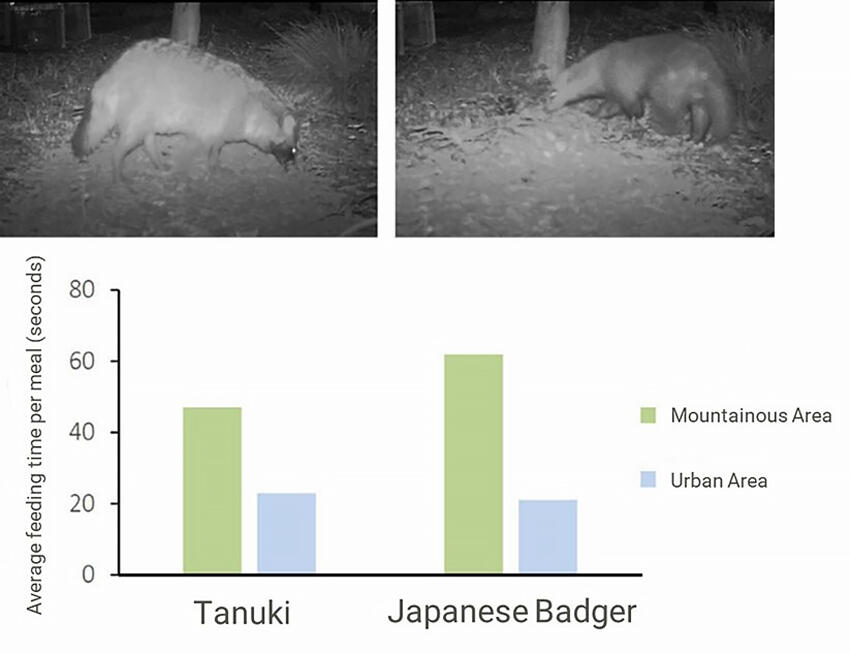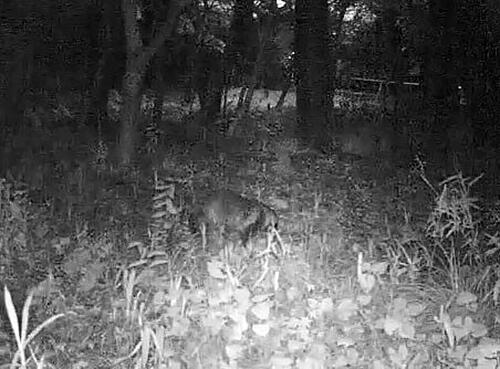Wildlife activity extends to urban areas, and the effects of wildlife activity, such as crop damage, animal cries, and traffic accidents, are often seen and heard by humans. On the other hand, how are animals affected by being in urban areas? A research group from the Tokyo University of Agriculture and Technology announced results that will provide clues to understanding this. It is said that tanuki (Japanese Racoon Dogs) and Japanese badgers quickly finish their meals at times and in places that are hidden from sight.

(provided by Tokyo University of Agriculture and Technology)
Inspiration comes while walking the dog
The extent to which urbanization affects animals depends on the wildlife species. Overseas there are surveys of behavioral changes in a variety of species due to large-scale urban development, and, while there are examples of these kinds of surveys in Japan for insects and birds, they had not been conducted for mammals.
Therefore, Professor Shinsuke Koike, who studies ecology at the Institute of Global Innovation Research, Graduate School of Agriculture, Tokyo University of Agriculture and Technology, decided to focus on mammals and to investigate dietary behaviors that are important for survival. Tanuki are a common species of wild mammals that inhabit urban areas in Japan, and the Japanese badger has also taken to living in urban areas recently.
The research began with daily dog walks. Shigeru Osugi, a doctoral research student at the United Graduate School of Agricultural Science, Tokyo University of Agriculture and Technology, was always interested in his dog's behavior of eating nuts and seeds on the side of the road. After consulting with Professor Koike, they decided to investigate how a variety of animals eat fallen nuts and seeds.
During the second year of the investigation, it was found that wild boars frequently flipped over the trees that were part of the survey, so a fence was set up in the survey area to prevent them from entering. After doing so, the animals' behavior patterns dramatically changed. According to Professor Koike, "By removing the wild boars, the other animals changed the places and times of their meals." The group believed that the animals might be changing their foraging behavior due to changes in the environment, so they decided to repeat the survey in another location.
At night, and quickly
Professor Koike and the other researchers surveyed a forest in an urban area where there is frequent human activity, as well as forests in a mountainous area where there is almost no human activity. For the urban area they choose the campus of International Christian University in Mitaka City, Tokyo, and for the mountainous area they chose the test forest at the Tama Forest Science Garden, Forestry and Forest Products Research Institute, in Hachioji City. Using cameras that can detect body temperature, they filmed tanuki and Japanese badgers eating fruit that had fallen from trees.
From those videos, they first counted the number of times that the animals were eating the fruit of yamazakura (wild cherry) trees. 11 trees were surveyed for 523 days in the mountainous area, and five trees were surveyed for 183 days in the urban area. During these periods, tanuki were observed eating 61 times in the mountainous area and 23 times in the urban area. Similarly, Japanese badgers were observed eating 53 times in the mountainous area and 24 times in the urban area.
In making these observations, Professor Koike and the other members of the research group noticed that eating at night was more common in the urban area than in the mountainous area. The tanuki in the mountainous area ate during the day approximately 20% of the time, but in the urban area all 23 times were at night. For Japanese badgers as well, they ate at night approximately 80% of the time in the mountainous area, but that number climbed to 96% in the urban area.
Next, when the research group examined the time spent eating per meal, they found that for both animals it was significantly shorter in the urban area than in the mountainous area. From this it can be said that tanuki and Japanese badgers in urban areas tend to quickly finish their meals during the dark hours of the night.

(Original image was provided by Tokyo University of Agriculture and Technology, and translated by JST)
Preferring to eat secretly rather than to eat a lot
So then, what kind of trees did the animals choose? Ginkgo trees, preferred by tanuki, and muku trees, preferred by Japanese badgers, were investigated. In examining this issue, the research group found that in urban areas there was a tendency for the animals to choose trees where it was difficult to be seen from the surrounding area, such as trees whose roots were surrounded by bushes, rather than trees that have a lot of fruit.
To eat efficiently the animals should choose trees that have a lot of fruit, and, in fact, fruit-eating wildlife such as birds, monkeys, and bears choose trees that have a lot of fruit. However, in the case of tanuki and Japanese badgers, it seems that, rather than eating more efficiently, it is more important for them to not be found by humans. Professor Koike stated that "In order to avoid danger and eat as quickly as possible, the tanuki and Japanese badgers are choosing behaviors that make them difficult to be spotted from the surrounding areas."
The research group consisted of members of the Tokyo University of Agriculture and Technology, Japan, and São Paulo State University, Brazil. The results were published on February 15 in the electronic edition of "Mammal Study," the Japanese academic journal on mammals.
Tanuki and Japanese badgers were found to adapt to urban environments by changing their foraging behaviors, which are vital to survival. Professor Koike suggested that "It is said that 'Tanuki don't pay any mind to humans,' but in reality that is not the case, and they live with great concern of humans. When considering our coexistence with wild animals, it is necessary to secure and protect locations where they can eat safely and with peace of mind."
I also often finish my meals quickly, but I primarily like to slowly enjoy my meals with my good friends and family. Neither tanuki or Japanese badgers want a human-friendly diet, and the Earth is not just for humans, so giving some thought and consideration to wild animals may also lead to people in urban areas getting to experience, even if just for brief moments or glimpses, the richness of nature.

(provided by Tokyo University of Agriculture and Technology)
(AOMATSU Kaori / Department for Promotion of Science in Society, Japan Science and Technology Agency)
Original article was provided by the Science Portal and has been translated by Science Japan.




